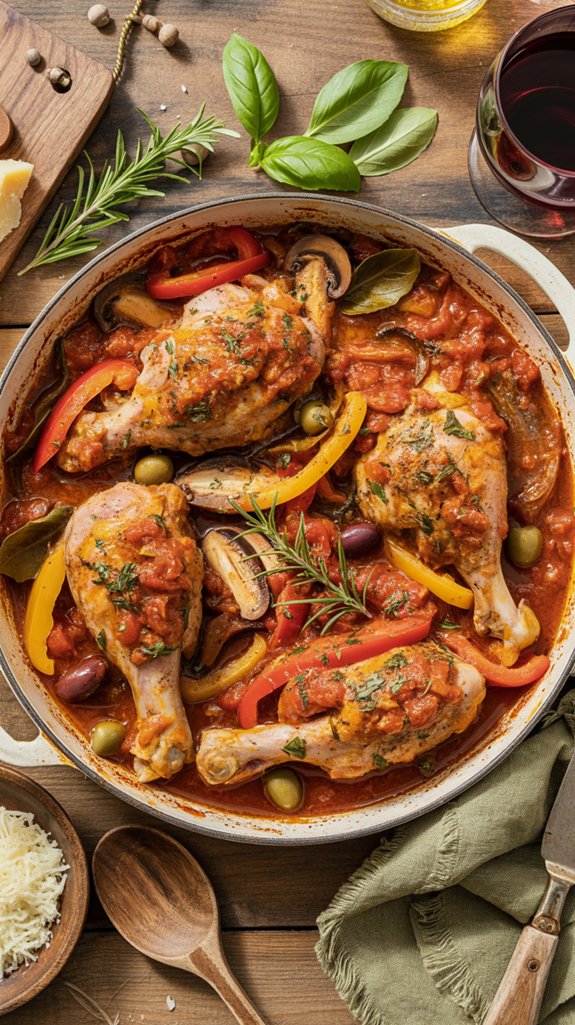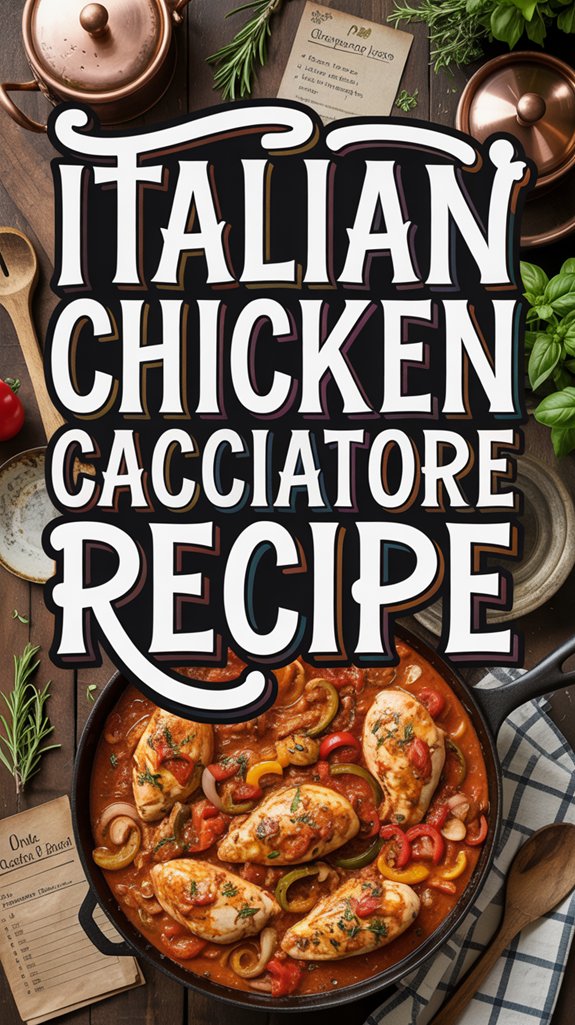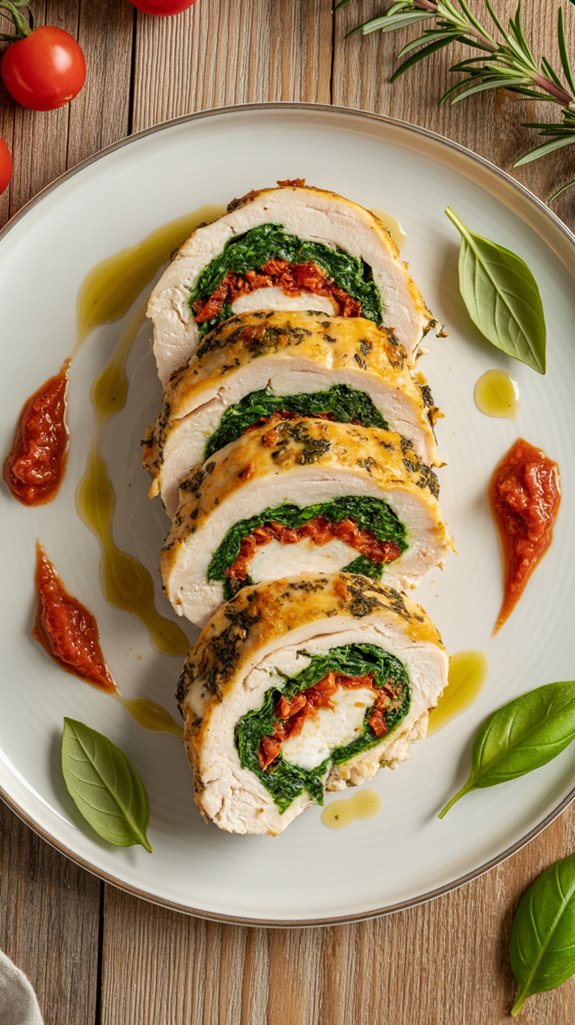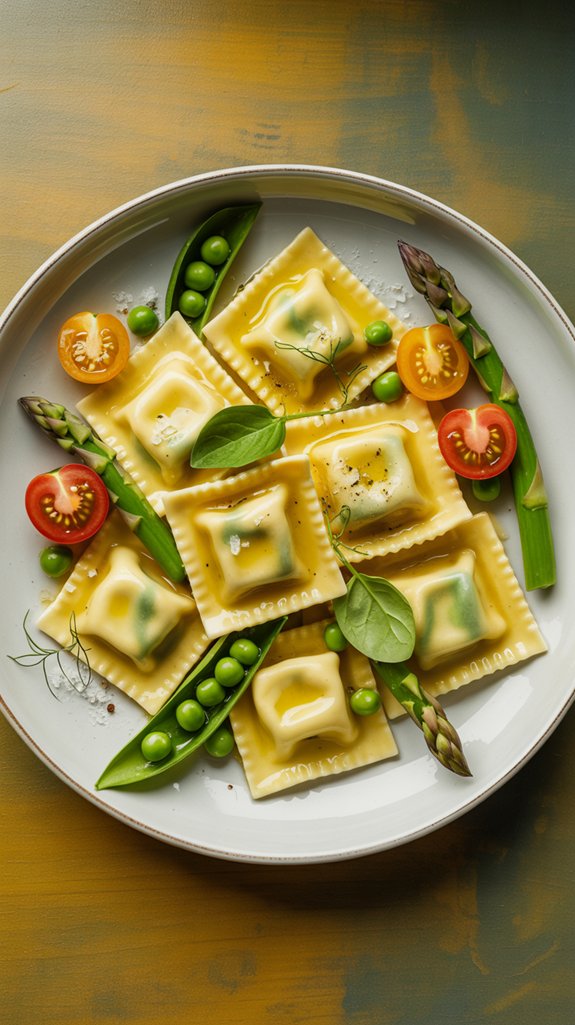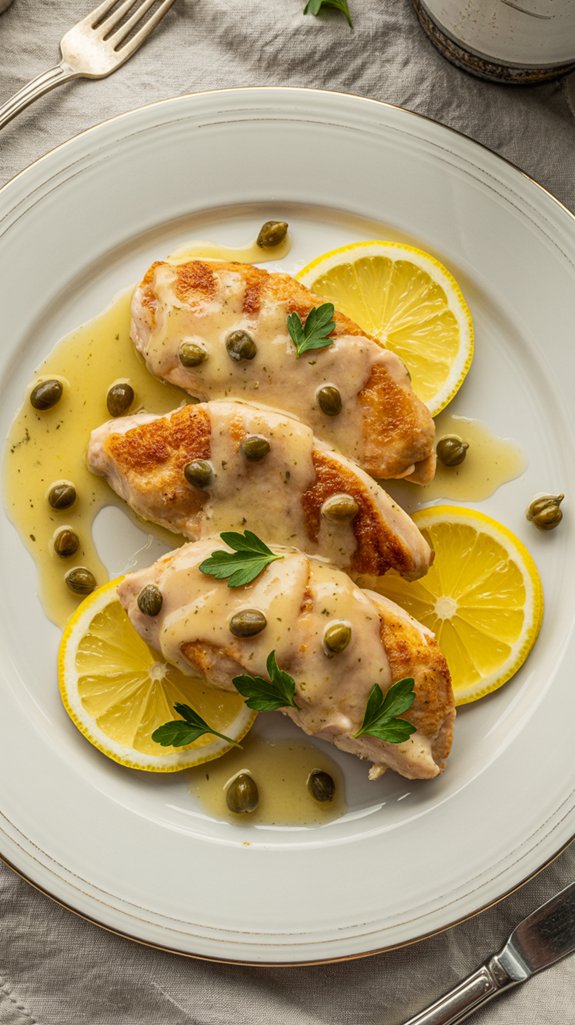Why You’ll Love This this Rustic Italian Chicken Cacciatore
This rustic Italian chicken cacciatore transforms simple ingredients into something that’ll have your kitchen smelling like a warm trattoria in Tuscany.
The combination of tender, golden-brown chicken simmered in a rich tomato sauce with pancetta, red wine, and aromatic herbs creates layers of flavor that taste like they’ve been developing for hours, even though it comes together in under an hour.
I mean, when you’ve got chicken fat mingling with olive oil, garlic sizzling with red pepper flakes, and wine deglazing all those beautiful browned bits from the pan, you know you’re in for something special.
Ingredients List
Here’s everything you’ll need to create this soul-warming Italian masterpiece that’ll make your whole house smell like you’ve been cooking all day.
- 3-4 lbs chicken breasts and thighs, cut up
- 1/4 teaspoon salt
- 1/4 teaspoon pepper
- 1/2 cup flour
- 7 tablespoons extra virgin olive oil
- 1 large onion, chopped
- 2 bay leaves
- 4 garlic cloves, crushed
- 4 tablespoons pancetta or bacon, chopped
- 1/2 teaspoon red pepper flakes
- 3 tablespoons parsley, chopped
- 1/2 cup red wine (Lambrusco only)
- 1 (1 lb) can Italian-peeled tomatoes
- 1 cup chicken stock, homemade
- 1/2 cup tomato sauce, homemade
A Few Things to Keep in Mind:
- While this recipe isn’t exactly a health food poster child with all that olive oil and pancetta, you’re getting plenty of lean protein from the chicken and lycopene from those beautiful tomatoes
- The garlic, onions, and herbs bring anti-inflammatory benefits to the party, so there’s that
- You can lighten things up by using skinless chicken pieces and reducing the olive oil slightly, though you’ll sacrifice some of that rich, traditional flavor
- The homemade stock and tomato sauce mean you control the sodium content, which is always a win in my book
Step by Step Directions
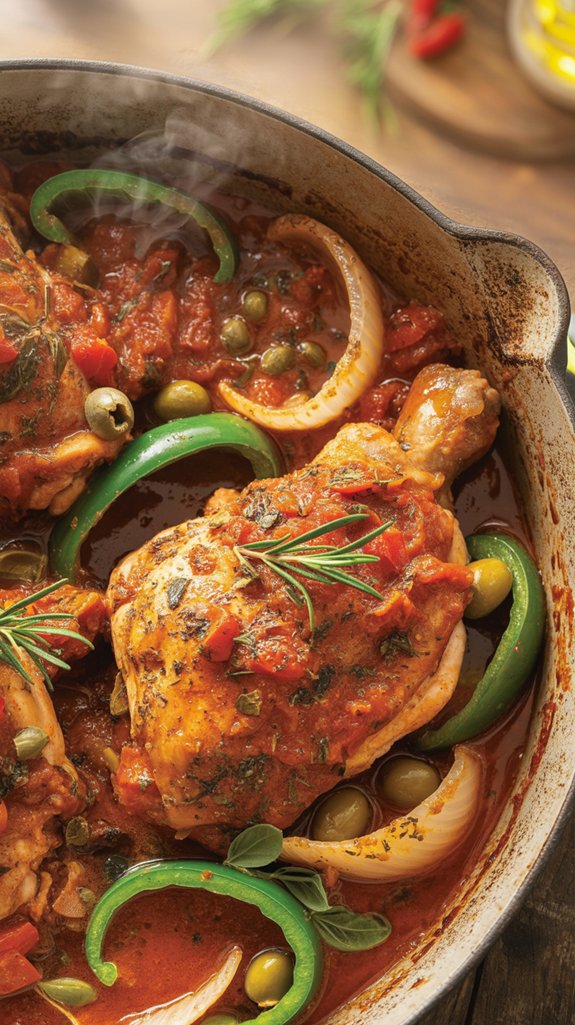
This classic Italian dish comes together in simple stages that build layers of rich, rustic flavor.
- Prepare the chicken: Sprinkle chicken pieces with salt, pepper, and flour, shaking off excess flour.
- Brown the chicken: Heat 4 tablespoons olive oil in a large non-stick high-sided frying pan over high heat, add chicken and cook until well-browned (about 3 minutes per side), then transfer to a plate.
- Start the base: Reserve chicken fat in pan and add enough remaining oil to make 4 tablespoons total, cook onion and bay leaves over medium heat until tender.
- Build the aromatics: Add garlic, pancetta, red pepper flakes, and half the parsley, cooking for 3 minutes.
- Deglaze: Pour in wine and cook for 3 minutes, stirring and scraping up browned bits from bottom of pan.
- Add tomatoes and simmer: Add canned tomatoes with juice, chicken stock, tomato sauce, and browned chicken pieces, breaking tomatoes into smaller pieces. Bring to boil then reduce heat and simmer revealed 15-20 minutes.
- Finish the sauce: Transfer chicken to serving dish, cook sauce 5 more minutes, taste for salt and pepper.
- Serve: Pour sauce over chicken and sprinkle with remaining parsley.
For best results, use a premium cookware set that provides even heat distribution and superior browning capabilities throughout the cooking process.
Substitutions and Variations
- Heat level adjustments: Cut back on the red pepper flakes if you’re cooking for sensitive palates, or bump them up if you like things spicy – start small though, because you can’t take it back once it’s in there.
- Herb variations: Fresh oregano or thyme make lovely additions alongside the parsley, and dried Italian seasoning works in a pinch when fresh herbs are nowhere to be found.
- Make it heartier: Some recipes add potatoes or carrots during the last 20 minutes of cooking, turning this into more of a one-pot wonder.
Additional Things to Serve With This Dish
This recipe pairs beautifully with so many sides that you’ll have trouble choosing just one.
- Creamy polenta or mashed potatoes – because that rich, tomatoey sauce deserves something smooth and comforting to soak into, and honestly, who doesn’t love a good carb situation.
- Crusty Italian bread or garlic bread – perfect for mopping up every last drop of that gorgeous sauce, which would be a crime to leave behind.
- Simple pasta like penne or rigatoni – toss it right in with the sauce for the last few minutes, or serve it alongside for a truly indulgent Italian feast.
- Roasted vegetables – zucchini, bell peppers, or eggplant complement the Mediterranean flavors without competing for attention.
- A crisp green salad – something light with lemon vinaigrette cuts through all that richness and makes you feel slightly more virtuous about going back for seconds.
- Risotto – if you’re feeling ambitious and want to create the kind of meal that’ll have people talking for weeks.
Cooking Tips & Tricks (Chef’s Notes)
Trust me, a few insider tricks can turn your cacciatore from good to absolutely restaurant-worthy.
- Don’t skip the flour dredging – it creates that gorgeous golden crust and helps thicken the sauce naturally as everything simmers together, plus it keeps the chicken from sticking to the pan like some kind of culinary disaster.
- Get that pan screaming hot before adding the chicken – we’re talking proper searing here, not gentle cooking, because that’s where all the flavor lives and you want those beautiful brown bits for the sauce.
- Resist the urge to move the chicken around – let it sit there and do its thing for the full 3 minutes per side, even if you’re getting antsy and want to peek underneath.
- Use the pancetta fat wisely – if you’re using bacon instead, save some of that rendered fat to cook the onions in, because bacon fat makes everything better and we’re not wasting liquid gold.
- Break up those canned tomatoes with your hands – not a spoon, not a knife, but your actual hands right in the can, which feels wonderfully messy and gives you the perfect rustic texture.
- Taste the sauce before serving – it might need a pinch more salt or a crack of black pepper, and this is your moment to be the hero who saved dinner.
- Let the sauce reduce properly – those final 5 minutes without the chicken are essential for concentrating all those flavors into something truly spectacular.
Nutritional Facts
This hearty Italian classic delivers substantial nutrition along with incredible flavor, making it a well-balanced meal that satisfies both your taste buds and dietary needs.
- Calories: Approximately 520-580 calories per serving (based on 6 servings)
- Protein: 45-50 grams per serving from the chicken, making this an excellent source of lean protein for muscle maintenance and growth
- Carbohydrates: 12-15 grams per serving, primarily from the tomatoes and onions, with minimal impact on blood sugar
- Fat: 28-32 grams per serving, mostly from the olive oil and chicken skin, providing healthy monounsaturated fats
- Fiber: 3-4 grams per serving from the vegetables and tomatoes, supporting digestive health
- Sodium: 680-750 mg per serving, which includes the pancetta and canned tomatoes
- Vitamin C: Excellent source from the tomatoes and bell peppers, supporting immune function
- Iron: Good source from the chicken and tomatoes, essential for healthy blood circulation
- Potassium: 650-700 mg per serving from chicken and tomatoes, important for heart health and blood pressure regulation
- Vitamin A: Moderate amount from the tomatoes, supporting eye health and immune function
- B Vitamins: Rich in niacin, B6, and B12 from the chicken, vital for energy metabolism and nervous system function
Fun “Did You Know?”
Did you know that Chicken Cacciatore literally translates to “hunter’s chicken” because Italian hunters would prepare this rustic dish using whatever ingredients they could forage or carry with them?
I find it fascinating that this recipe’s flexibility stems from necessity—hunters couldn’t predict what vegetables or herbs they’d find.
That’s why you’ll see countless variations across Italian regions. Some use bell peppers, others add mushrooms or olives. The wine choice varies too, though I specify Lambrusco for authenticity.
This adaptability makes Cacciatore perfect for using whatever’s in your pantry, just like those resourceful hunters centuries ago.

